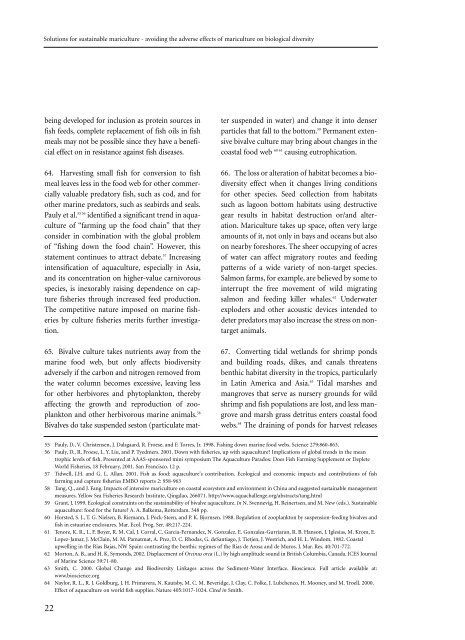Solutions for sustainable mariculture - Convention on Biological ...
Solutions for sustainable mariculture - Convention on Biological ...
Solutions for sustainable mariculture - Convention on Biological ...
- No tags were found...
Create successful ePaper yourself
Turn your PDF publications into a flip-book with our unique Google optimized e-Paper software.
<str<strong>on</strong>g>Soluti<strong>on</strong>s</str<strong>on</strong>g> <str<strong>on</strong>g>for</str<strong>on</strong>g> <str<strong>on</strong>g>sustainable</str<strong>on</strong>g> <str<strong>on</strong>g>mariculture</str<strong>on</strong>g> - avoiding the adverse effects of <str<strong>on</strong>g>mariculture</str<strong>on</strong>g> <strong>on</strong> biological diversitybeing developed <str<strong>on</strong>g>for</str<strong>on</strong>g> inclusi<strong>on</strong> as protein sources infish feeds, complete replacement of fish oils in fishmeals may not be possible since they have a beneficialeffect <strong>on</strong> in resistance against fish diseases.64. Harvesting small fish <str<strong>on</strong>g>for</str<strong>on</strong>g> c<strong>on</strong>versi<strong>on</strong> to fishmeal leaves less in the food web <str<strong>on</strong>g>for</str<strong>on</strong>g> other commerciallyvaluable predatory fish, such as cod, and <str<strong>on</strong>g>for</str<strong>on</strong>g>other marine predators, such as seabirds and seals.Pauly et al. 55 56 identified a significant trend in aquacultureof “farming up the food chain” that theyc<strong>on</strong>sider in combinati<strong>on</strong> with the global problemof “fishing down the food chain”. However, thisstatement c<strong>on</strong>tinues to attract debate. 57 Increasingintensificati<strong>on</strong> of aquaculture, especially in Asia,and its c<strong>on</strong>centrati<strong>on</strong> <strong>on</strong> higher-value carnivorousspecies, is inexorably raising dependence <strong>on</strong> capturefisheries through increased feed producti<strong>on</strong>.The competitive nature imposed <strong>on</strong> marine fisheriesby culture fisheries merits further investigati<strong>on</strong>.65. Bivalve culture takes nutrients away from themarine food web, but <strong>on</strong>ly affects biodiversityadversely if the carb<strong>on</strong> and nitrogen removed fromthe water column becomes excessive, leaving less<str<strong>on</strong>g>for</str<strong>on</strong>g> other herbivores and phytoplankt<strong>on</strong>, therebyaffecting the growth and reproducti<strong>on</strong> of zooplankt<strong>on</strong>and other herbivorous marine animals. 58Bivalves do take suspended sest<strong>on</strong> (particulate mattersuspended in water) and change it into denserparticles that fall to the bottom. 59 Permanent extensivebivalve culture may bring about changes in thecoastal food web 60 61 causing eutrophicati<strong>on</strong>.66. The loss or alterati<strong>on</strong> of habitat becomes a biodiversityeffect when it changes living c<strong>on</strong>diti<strong>on</strong>s<str<strong>on</strong>g>for</str<strong>on</strong>g> other species. Seed collecti<strong>on</strong> from habitatssuch as lago<strong>on</strong> bottom habitats using destructivegear results in habitat destructi<strong>on</strong> or/and alterati<strong>on</strong>.Mariculture takes up space, often very largeamounts of it, not <strong>on</strong>ly in bays and oceans but also<strong>on</strong> nearby <str<strong>on</strong>g>for</str<strong>on</strong>g>eshores. The sheer occupying of acresof water can affect migratory routes and feedingpatterns of a wide variety of n<strong>on</strong>-target species.Salm<strong>on</strong> farms, <str<strong>on</strong>g>for</str<strong>on</strong>g> example, are believed by some tointerrupt the free movement of wild migratingsalm<strong>on</strong> and feeding killer whales. 62 Underwaterexploders and other acoustic devices intended todeter predators may also increase the stress <strong>on</strong> n<strong>on</strong>targetanimals.67. C<strong>on</strong>verting tidal wetlands <str<strong>on</strong>g>for</str<strong>on</strong>g> shrimp p<strong>on</strong>dsand building roads, dikes, and canals threatensbenthic habitat diversity in the tropics, particularlyin Latin America and Asia. 63 Tidal marshes andmangroves that serve as nursery grounds <str<strong>on</strong>g>for</str<strong>on</strong>g> wildshrimp and fish populati<strong>on</strong>s are lost, and less mangroveand marsh grass detritus enters coastal foodwebs. 64 The draining of p<strong>on</strong>ds <str<strong>on</strong>g>for</str<strong>on</strong>g> harvest releases55 Pauly, D., V. Christensen, J. Dalsgaard, R. Froese, and F. Torres, Jr. 1998. Fishing down marine food webs. Science 279:860-863.56 Pauly, D., R. Froese, L. Y. Liu, and P. Tyedmers. 2001. Down with fisheries, up with aquaculture? Implicati<strong>on</strong>s of global trends in the meantrophic levels of fish. Presented at AAAS-sp<strong>on</strong>sored mini symposium The Aquaculture Paradox: Does Fish Farming Supplement or DepleteWorld Fisheries, 18 February, 2001. San Francisco. 12 p.57 Tidwell, J.H. and G. L. Allan. 2001. Fish as food: aquaculture's c<strong>on</strong>tributi<strong>on</strong>. Ecological and ec<strong>on</strong>omic impacts and c<strong>on</strong>tributi<strong>on</strong>s of fishfarming and capture fisheries EMBO reports 2: 958-96358 Tang, Q., and J. Fang. Impacts of intensive <str<strong>on</strong>g>mariculture</str<strong>on</strong>g> <strong>on</strong> coastal ecosystem and envir<strong>on</strong>ment in China and suggested <str<strong>on</strong>g>sustainable</str<strong>on</strong>g> managementmeasures. Yellow Sea Fisheries Research Institute, Qingdao, 266071. http://www.aquachallenge.org/abstracts/tang.html59 Grant, J. 1999. Ecological c<strong>on</strong>straints <strong>on</strong> the sustainability of bivalve aquaculture. In N. Svennevig, H. Reinertsen, and M. New (eds.). Sustainableaquaculture: food <str<strong>on</strong>g>for</str<strong>on</strong>g> the future? A. A. Balkema, Rotterdam. 348 pp.60 Horsted, S. J., T. G. Nielsen, B. Riemann, J. Pock-Steen, and P. K. Bjornsen. 1988. Regulati<strong>on</strong> of zooplankt<strong>on</strong> by suspensi<strong>on</strong>-feeding bivalves andfish in estuarine enclosures. Mar. Ecol. Prog. Ser. 48:217-224.61 Tenore, K. R., L. F. Boyer, R. M. Cal, J. Corral, C. Garcia-Fernandez, N. G<strong>on</strong>zalez, E. G<strong>on</strong>zalea-Gurriaran, R. B. Hans<strong>on</strong>, J. Iglesias, M. Krom, E.Lopez-Jamar, J. McClain, M. M. Pamatmat, A. Prez, D. C. Rhodas, G. deSantiago, J. Tietjen, J. Westrich, and H. L. Windom. 1982. Coastalupwelling in the Rias Bajas, NW Spain: c<strong>on</strong>trasting the benthic regimes of the Rias de Arosa and de Muros. J. Mar. Res. 40:701-772.62 Mort<strong>on</strong>, A. B., and H. K. Sym<strong>on</strong>ds, 2002. Displacement of Orcinus orca (L.) by high amplitude sound in British Columbia, Canada. ICES Journalof Marine Science 59:71-80.63 Smith, C. 2000. Global Change and Biodiversity Linkages across the Sediment-Water Interface. Bioscience. Full article available at:www.bioscience.org64 Naylor, R. L., R. J. Goldburg, J. H. Primavera, N. Kautsby, M. C. M. Beveridge, J. Clay, C. Folke, J. Lubchenco, H. Mo<strong>on</strong>ey, and M. Troell. 2000.Effect of aquaculture <strong>on</strong> world fish supplies. Nature 405:1017-1024. Cited in Smith.22
















